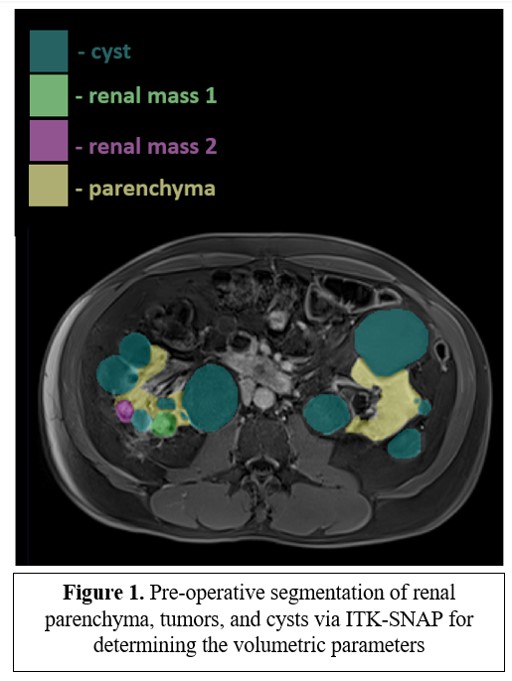Back
Poster, Podium & Video Sessions
Moderated Poster
MP33: Uroradiology I
MP33-07: MRI-based segmentation of preoperative renal parenchyma in Von Hippel Lindau disease to predict postoperative renal functional decline
Saturday, May 14, 2022
4:30 PM – 5:45 PM
Location: Room 228
Maria Antony*, Pouria Yazdian, Aditi Chaurasia, Nikhil Gopal, Zach Kozel, Mina Dehghani Firouzabadi, Maryam Homayounieh, Safa Samimi, Rabindra Gautam, Sandeep Gurram, Ashkan Malayeri, Marston Linehan, Mark Ball, Bethesda, MD

Maria B. Antony, BS
University of Connecticut School of Medicine
Poster Presenter(s)
Introduction: Von Hippel-Lindau is a hereditary disease with various renal manifestations including renal cysts and solid tumors. Patients are at risk for bilateral, multifocal and recurrent tumors requiring multiple surgeries. Preoperative imaging can assess surgical and oncologic risk, but few studies have examined risk of functional sequalae. In this study, we sought to correlate post-op renal function with MRI-based volumetric analysis.
Methods: We identified VHL patients undergoing partial nephrectomy at the National Cancer Institute from 2015-2020 with available preoperative MRI. Renal tumors, cysts, and parenchyma of the operated kidney were manually segmented using ITK-SNAP software (Fig. 1). Kidney parenchyma was defined as renal tissue not affected by tumors or cysts. Volumetric data was extracted using PyRadiomics library.
Serum creatinine and urinalysis was assessed at pre-op, post-op day 1 (POD1), 3- and 12-month timepoints. eGFR was calculated using creatinine based MDRD equation. Statistical analysis was conducted on R Studio v 4.1.1.
Results: 116 patients (63 males with median age 48 years) were analyzed with median 3 (IQR: 2-5) tumors and 5 (IQR: 2-12) cysts per kidney. Median preoperative GFR was 70 (IQR 58-88), with GFR preserved at POD 1, 3 months and 12 months follow-up at 76, 90, and 91 percent respectively.
On regression analysis, pre-operative kidney parenchymal volume negatively correlated with % preoperative GFR preserved at POD1 (r=-0.367 p=0.034), but not at 3 or 12 months. Comparing patients with a preop GFR <60 to those with GFR>60, number of tumors was higher in lower GFR cohort (4 tumors, IQR 2-7 VS 3 tumors, IQR 1-4, p=0.016, Wilcoxon-Rank Sum), which persisted at 12 months (p=0.036).
Among patients who developed proteinuria at 3-6 months after surgery, degree of proteinuria was related to the number of tumors identified at pre-op (p=0.005, Wilcoxon-Rank Sum). Across all post-op timepoints, both number and volume of renal cysts were not associated renal disease.
Conclusions: Preoperative MRI offers insight into renal function after surgery. Parenchymal volume before surgery was not associated with long term renal functional outcomes, likely due to renal compensation. Tumor, but not cyst burden was related to functional outcomes post-surgery.
Source of Funding: NIH MRSP

Methods: We identified VHL patients undergoing partial nephrectomy at the National Cancer Institute from 2015-2020 with available preoperative MRI. Renal tumors, cysts, and parenchyma of the operated kidney were manually segmented using ITK-SNAP software (Fig. 1). Kidney parenchyma was defined as renal tissue not affected by tumors or cysts. Volumetric data was extracted using PyRadiomics library.
Serum creatinine and urinalysis was assessed at pre-op, post-op day 1 (POD1), 3- and 12-month timepoints. eGFR was calculated using creatinine based MDRD equation. Statistical analysis was conducted on R Studio v 4.1.1.
Results: 116 patients (63 males with median age 48 years) were analyzed with median 3 (IQR: 2-5) tumors and 5 (IQR: 2-12) cysts per kidney. Median preoperative GFR was 70 (IQR 58-88), with GFR preserved at POD 1, 3 months and 12 months follow-up at 76, 90, and 91 percent respectively.
On regression analysis, pre-operative kidney parenchymal volume negatively correlated with % preoperative GFR preserved at POD1 (r=-0.367 p=0.034), but not at 3 or 12 months. Comparing patients with a preop GFR <60 to those with GFR>60, number of tumors was higher in lower GFR cohort (4 tumors, IQR 2-7 VS 3 tumors, IQR 1-4, p=0.016, Wilcoxon-Rank Sum), which persisted at 12 months (p=0.036).
Among patients who developed proteinuria at 3-6 months after surgery, degree of proteinuria was related to the number of tumors identified at pre-op (p=0.005, Wilcoxon-Rank Sum). Across all post-op timepoints, both number and volume of renal cysts were not associated renal disease.
Conclusions: Preoperative MRI offers insight into renal function after surgery. Parenchymal volume before surgery was not associated with long term renal functional outcomes, likely due to renal compensation. Tumor, but not cyst burden was related to functional outcomes post-surgery.
Source of Funding: NIH MRSP


.jpg)
.jpg)